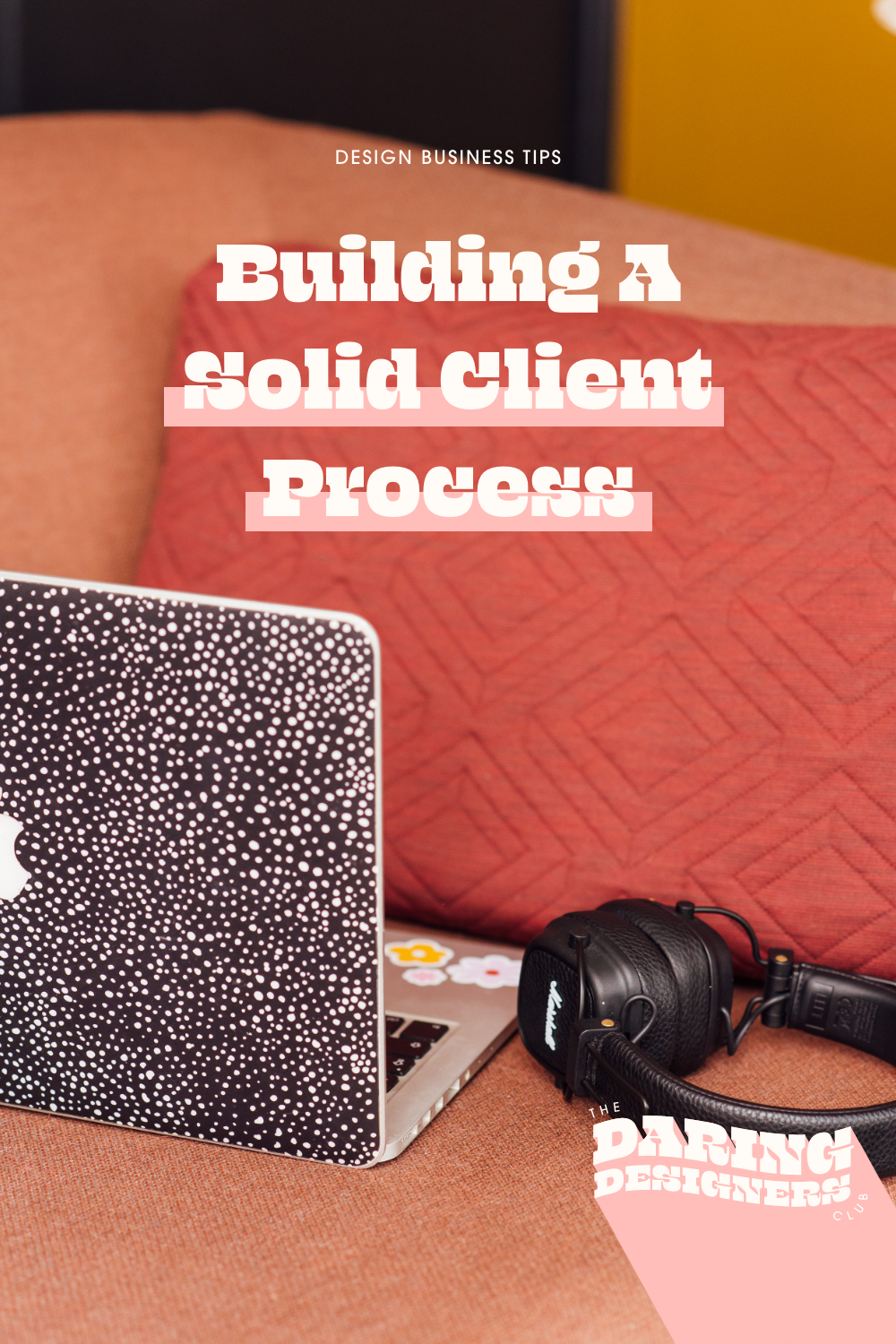How to Build a Great Client Process for Your Design Business
PREFER TO LISTEN?
Listen to the podcast instead! An episode that perfectly fits this topic is here for you to listen below and if you want to listen on the go, search 'The Daring Designers Club Podcast' wherever you listen to podcasts for more design business insider tips, personal stories and advice.
WHAT IS A CLIENT PROCESS?
When I’m talking about process, I’m talking about your client process and the admin side of things instead of your design process. This includes things like enquiries, client communication, sending concepts, revisions etc. Whereas your design process is also very important but more focused on how you work as a designer - something I’m sure you’ve perfected yourself!
What’s much harder to plan or get used to is your client or business proces. Your client process is a step by step action guide which you follow for every client you have as you work through your projects. It stays the same to make sure you always know where you are up to and what you need to do next and it keeps you on track and organised with projects.
You have your process in place so at whatever part of a project you are at, whether it’s right at the beginning when you get an enquiry, if you’re in the middle of the project designing away or right at the end when you’re passing over files and asking for feedback, you have a map to follow so you know exactly what to send, what you need and what’s going to happen next.
The main benefits to having something like this in place are that your projects are naturally more organised as you know exactly what happens when. Your clients will feel more reassured and happy working with you as they’re being guided through a new experience step by step and it also makes your services feel much more premium and worth the investment instead of getting scattered emails with no set dates or plan of what will happen.
You might now be thinking, what makes a good client process then? What do I need to make sure I include in my process to get all of these benefits and make my life and my clients lives easier?
BUILDING YOUR PROCESS
How do you bring yours together and build your own process and then how do you implement it?
Your Process Plan
Grab yourself a pen and some paper and I would spend some time writing down every part of your current services and everything that needs to happen within those projects.
We want every single part of your projects covered and the easiest way to plan this is to split your process into three parts:
Onboarding (everything from someone getting in touch to booking the project in and getting signed contracts and payments)
Project process (everything that happens within the project from anything you need your client to send to you before you start, going through the design process, and then finishing up your designs and the project)
Offboarding process (anything you need to happen when the project is finished like sending over files, following up, and getting feedback)
Your Process Steps
Put everything you need in place for your process to happen. Go through each step of the process you’ve planned and see what is needed for each one. This is going to be different for everyone so go with your plan and create everything you need to support the process.
A few things which are really helpful to help get your process in place are:
Contact forms or information on your website
Canned or template emails which you can send at each part of the process
Appointment schedulers or a system to help clients book a suitable time to talk to you
Document templates for contracts, forms, invoices and proposals
Systems you want to use for communication, project management or client management
Testing Your Process
Now it might seem like you have everything in place, but the last thing you need to do for your client process is to test it. It might seem like you have it all set and everything is going to be perfect and work for every project but there’s a big difference between planning out a process how you hope it will go and then having it work out in practice.
You might find that once you’ve tried the process out with a few clients, some steps work out better at different stages or some bits aren’t as necessary as you thought or there might need to be some extra reminders in certain places.
Don’t worry at all if the process doesn’t work out 100% straight away, the whole point is that we can be flexible and move things around to keep improving it over time and making sure it is serving you and your clients in the best way possible.
GREAT SYSTEMS TO USE
Some systems you may want to integrate into your process:
G Suite - Google’s business system is great to manage emails, your calendar and arrange files in Google Drive.
Asana - A project management tool which you can use to track tasks, communicate with clients and also gather feedback and files.
Trello - Similar to Asana but works by having cards and boards instead of to do lists.
Dubsado - A great client management tool which can manage your invoicing, contracts, forms and also includes amazing automation and probably too many functions to mention in this small snippet.
Zapier - Another amazing automation tool which works by combining other tools you use and works on tasks in the background without you even knowing.
Hello Bonsai - Another client management tool which manages invoices, contracts etc but doesn’t have some of the more extended options that Dubsado has.
Pick and choose which tools work for you and you generally only need to use one or a couple if any! You may even find that you can run your process quite easily just using old fashioned email.
Want More Advice for Designers?
Sign up to my newsletter, The Daring Designers Club, for fortnightly business tips and resources!
PIN THIS POST TO PINTEREST



